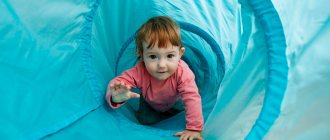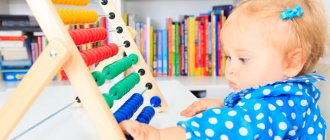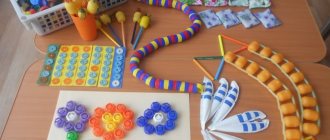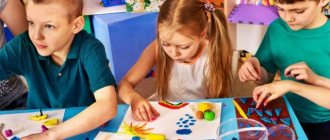Motor skills are understood as a set of consistent and voluntary movements necessary to perform a specific action, for example, sit down, take a step, or clench your hand into a fist. For adults, all these movements are natural and absolutely not difficult thanks to years and decades of training. In addition, the very first attempts to make such simple movements and the difficulties associated with them are not stored in human memory. Motor skills can be divided into two types:
- gross motor skills refer to the development of automatic movement of an entire group of muscles;
- fine motor skills refer only to the precise movements of the hand and the processes that coordinate the joint work of the hands and the visual apparatus.
With the help of research, it was possible to find out that the development of gross and fine motor skills in children is based on the development of the brain and the emergence of new connections between its neurons. Indeed, at the time of birth, the baby’s central nervous system is still defective, so the newborn can only move his limbs aimlessly and is unable to focus his gaze even on a large object. But, since the peak of development processes occurs precisely at the moment of birth, by the age of one month the baby’s motor functions are progressing greatly.
Children's gross motor skills
At monthly checkups throughout the baby's first year of life, the pediatrician assesses the progress of the child's gross and fine motor skills. Then such checks occur less frequently, but continue to be important, since they make it possible to make sure that each achievement of the baby corresponds to a long-known sequence. That is, this says that the development of the central nervous system, muscles and musculoskeletal system of the child corresponds to age standards. Progression of gross motor skills depending on age:
- During the first two months, the newborn is able to lie on his back, turn his head, and limb movements become more conscious.
- At 3-5 months, the child controls his head more and more confidently, and can even lift it along with his shoulders while lying on his stomach. He can bring his palms together, but it’s still too early to play palm games with him.
- At 6-8 months, the baby’s hands are already able to grasp, and thanks to them he pulls himself up, trying to sit up from a position lying on his back. At 8 months he will already learn to sit without assistance. A little later, the baby will learn to sit up while lying on his stomach.
- From 9 to 11 months, Butuz enthusiastically studies the world around him. In this he is helped by the ability to crawl confidently and, adhering to support, to stand on his feet.
- At 12-14 months, the baby continues to grow up quickly, sometimes even delighting with the first steps towards his first anniversary. For now it looks rather ridiculous - arms extended forward and legs spread wide apart, but it will do for a start. Within two months, the baby will begin to climb onto low chairs and sofas and pick up various objects from the floor.
- At 15-17 months, the toddler already walks quite confidently, can step to the sides and back away. He becomes interested in playing ball because his motor skills have developed so much that he can kick objects.
- At 18-20 months, the baby, holding hands, will be able to go up and down the stairs for the first time, and will make his first attempts to jump and run.
- At the age of 21-23 months, jumping and running will become commonplace; the baby eagerly tries to master a tricycle and tries to sit confidently at the table.
- At two years old, Butuz learns to maintain balance, walking along the curb and trying not to fall. He can already run perfectly, almost without falling, and jump down.
- At three years old, a child already descends the stairs like an adult - not with side steps, but with alternating steps.
- By the age of four, movements become even more confident: the child is able to stand on one leg for 10 seconds, deftly catches a ball, and confidently rides a bicycle.
- By the age of five, once difficult movements turn into automatic ones, the child easily and naturally sits, jumps and runs, easily jumps over obstacles, and is able to distinguish between right and left.
How is the child's motor skills developing?
A child's motor skills are consciously and unconsciously trained and improved from the first day after birth.
- As you know, by the sixth month of life, a baby should hold his head up and roll over from back to side. Be able to sit down holding an adult's finger.
- A baby up to one year of age must sit without support, crawl, put objects in containers, and hit them against each other.
- A child under 2 years old can walk, run, jump independently, arms wide apart, manipulate objects, roll a ball. And also climb up and down the stairs, holding onto the railings, and climb on your toes.
- A child under 3 years old should be able to climb stairs without the help of handrails and avoid obstacles. Definitely make attempts at self-care. However, he still needs support and help because his movements are not yet precise enough. During this period, basic “locomotive” actions are best mastered. The range of motor skills is expanding at a particularly rapid pace.
- Preschool child: Uses devices effectively, runs and jumps freely. His hand-eye coordination develops, his balance and vestibular apparatus improve, and his dexterity of movements is honed. By the end of the preschool period, the child fully masters all self-care skills. Able to combine several motor actions into a sequence. Grabs, throws, climbs a wall, a rope, over a fence. Copies the actions of others.
- Children of primary school age master almost half of the movements characteristic of an adult. They have skills in self-care, hygiene, care of clothes and room, and handling simple tools. Movements become harmonious, rhythmic and smooth. The age of 9-12 years is the “golden period of mobility.”
- During puberty, motor development tends to become unbalanced. There is a deterioration in the coordination of movements and the accuracy of their execution. In general, this is due to the fact that different organs and parts of the body develop in leaps and bounds. For example, for a couple of months only the legs grow rapidly, then the arms and neck. The growth of different organs and parts of the body is not interconnected. No wonder they say: “awkward, like a teenager.”
- By the age of 18-20, as a rule, the growth of the motor system is completed, the imbalances are leveled out and the quality of motor skills reaches the best levels.
Development of children's fine motor skills
It is now believed that the foundation of a child’s future talents and abilities is the development of fine motor skills. After all, the centers responsible for it are located in close proximity to the zones of thinking, attention, imagination, coordination, speech, observation, motor and visual memory. We should also not forget about the close connection between speech and the development of fine motor skills, which has been scientifically proven, so special attention should be paid to it. In general, the development of fine motor skills greatly influences the child’s subsequent life; he will need coordinated actions of his hands and fingers for many life manipulations:
- write;
- paint;
- fasten buttons.
Games that develop fine motor skills are very important, because during the game the baby subconsciously remembers the order of movements and learns to coordinate them, and together with jokes, games perfectly help the development of speech. As a result, you can get great benefits from games in the most natural way. At the same time, the main thing to remember is that the development of fine motor skills in children follows certain patterns: first, the child should master the simplest movements, and only after that you can move on to learning new, more complex ones. If the baby does not immediately grasp a new movement, you should not be too upset, but it is better to retreat to your previous positions and try to learn something simpler.
The danger of insufficient development of gross motor skills
As children age, they reach higher and higher stages of gross motor development. For example, by age 3-4 they can usually hop with two feet, and by age 7-8 they can ride a bike without training wheels.
If a child regularly misses these stages or is not active for a long time, it may be a sign of a condition called developmental coordination disorder, or dyspraxia, a condition that causes the child to have difficulty performing everyday activities.
If you have concerns about your child's motor skills, talk to your child's doctor. And read about how problems with feeling can affect motor skills.
Remember that insufficient development of gross motor skills can affect a child's self-esteem and social life!
Calendar for the development of children's fine motor skills
Listed below are the basic actions associated with fine motor skills, the development of which is inherent in children of a certain age.
From birth to 4 months
At the beginning of life, the baby learns to move his limbs, while trying to reach a toy or other object that interests him. There is no difference in control over the right or left hand. At the same time, babies learn to coordinate eye and head movements. For example, hearing the mother’s voice, the baby turns his head in that direction. He can even grab a toy with his hands, however, this will still not be a conscious, but a reflexive movement.
4-12 months
Then, until reaching the age of one, the baby begins to control his hands better and better. If at first he could carry out some actions only with two hands, now he can do it with one. The baby is already quite consciously grabbing the toy. After six months he can grasp an increasingly smaller object. Since by the age of one year the baby is able to grasp even the smallest object with his fingers, this, if neglected, can lead to airway obstruction. In addition, during this period, children learn to transfer objects from hand to hand, turn pages in their favorite books and kick a ball.
1-2 years
In a sitting position, the baby confidently maintains his balance, and he no longer needs to help himself with his hands to do this. He uses the latter more for games. Children of this age still do not give preference to the right or left hand, but by the end of this period the dominance of one of the hands makes itself felt. Finger movements become more and more confident. Although the baby continues to hold the pencil with his entire palm, he is already trying to burst the soap bubble with his index finger. If up to two years he can only draw circles, then at two years vertical and horizontal lines already emerge from under his brush.
2-3 years
In the third year of life, coordination, balance and body control leave more room for the hands and fingers. Most often, the forearm and hand are involved in the movements. After two years, the child’s drawing style changes - he now holds a pencil as if he were pointing it at a sheet of paper. Towards the end of this period, circles and lines begin to turn out better, and some drawings begin to appear based on them. A three-year-old child should be able to cut a sheet of paper in half, although not too straight.
3-4 years
The baby finds use for both hands: if he confidently holds a pencil with his dominant hand, then with the help of the second, auxiliary hand, he fixes a sheet of paper. His drawings are becoming more and more complicated, the baby strives to copy figures from coloring books or books. By the age of four, he holds a pencil or pen, like adults - with three fingers. From this moment on, he can be considered ready to master writing. He also works much more confidently with scissors - he can cut along a drawn line.
4-5 years
Finger motor skills at this age reach such a level of development that the baby makes many movements with just one hand, without unnecessarily using the shoulder and forearm. He paints better, without going beyond the outline of the figure, and can cut out a square very easily.
5-6 years
Hand movements are very harmonious and coordinated. The baby should confidently hold a pen with three fingers, and scissors - just like adults. When coloring, he is able to take into account small details. For preschoolers, sufficient development of fine motor skills should provide access to further productive learning in the elementary grades. Therefore, parents should carefully monitor this process, ensuring that development does not lag behind the maturation calendar.
Exercises that develop fine motor skills
- Games “Who has arrived?” and “Hello, finger!” are exercises for finger motor skills. If you use your imagination when staging them, you can get real theater.
- You can roll plasticine balls or ask your child to mold a specific object: starting with the simplest and gradually complicating the task.
- Let the baby tear the paper into pieces - the smaller they are, the better his fine motor skills are developed.
- Let your child sort out rosaries, beads, and other small objects of different shapes and textures, thanks to which he will simultaneously develop a sense of touch.
- Let the baby fasten the buttons, tie and then untie the knots. In this case, you need to adhere to the principle “from big to small”.
Exercises that develop tactile sensitivity and movements of the hands and fingers with complex coordination:
- Let the child put his hands into a vessel filled with homogeneous material (water, sand, pellets, any cereals, small objects), and mix its contents for 1-2 minutes. After this, offer him a vessel with filler that has a different texture. When the baby makes several similar tests, he should be blindfolded and offered another vessel for immersion of his hands, and he should, by feeling the contents with his fingers, blindly guess what it is filled with.
- Guessing signs (letters, numbers, figures) tactilely “written” on both hands.
- Modeling from plasticine the same numbers, letters or geometric shapes. Schoolchildren can sculpt not only printed, but also handwritten letters. After this, the child with his eyes closed must identify the molded signs.
- Roll the pencil between the fingers - from the thumb to the little finger and back, alternately for both hands.
- Games with household objects. You can take a bright tray onto which you can sprinkle any cereal in a thin layer. Then let the child run his finger along the cereal - you will get a multi-colored line. Let him randomly draw a few chaotic lines, after which you can draw letters or specific objects (waves, rain, fence) together with him.
- Choose different-sized and multi-colored buttons, with the help of which first let the adult himself lay out some kind of drawing, and then ask the child to repeat it. When the baby learns to do this on his own, he can come up with his own drawings. You can create a lot of mosaics from buttons: a butterfly, a tumbler, beads, balls, a snowman, a mushroom, etc.
The connection between gross motor skills and psychophysical qualities
We use gross motor skills to perform everyday tasks that involve our large muscles - from general exercise to raking leaves in the garden. Most people have little difficulty using these skills without thinking, automatically. However, the development of gross motor skills is a more complex issue than it seems at first glance.
Gross motor skills are the coordinated actions of the musculoskeletal and nervous systems. She is responsible for balance and coordination. It also forms the basis for fine motor skills that help move the hands, feet, fingers and toes.
Gross motor skills are associated with the following psychophysical qualities:
- Balance - maintaining balance.
- Coordination is the coordination of the activity of various muscles of the body when performing a motor task.
- Proprioception is the sense of the position of parts of your body relative to each other.
- Physical strength.
- Speed reaction.
All these abilities help children successfully participate in kindergarten and school activities, perform everyday activities at home, celebrate friends’ birthdays, play with them in the yard, on playgrounds and sports grounds.
Nowadays, there is no shortage of means for developing general motor skills and the physical qualities of a child closely related to it. Thus, for kindergartens, the Lazalka online store offers a variety of children’s playgrounds, sports complexes, as well as children’s exercise equipment, such as “Rowing”, “Rider”, “Twister”, “Wave Runner”, which serve to develop the strength of various muscle groups as well as coordination of movements, flexibility and mobility of joints.
Parents can also choose sports and play equipment for their children that develops general motor skills for home: sports complexes, trampolines, swimming pools, wall bars, horizontal bars, chain and rope ladders, gymnastic rings, ropes, etc.
Now imagine what physical education classes or playing with other children are like for a child with underdeveloped gross motor skills.
Toys for the development of children's fine motor skills
- You can develop fine motor skills with a wide variety of objects that can be used for educational games. Dry beans or peas, for example, are perfect for this purpose. You can mix several types of legumes and invite your child to sort them. For children under three years old, such an activity is still too early and even fraught, but for three-year-olds and older it will be very useful to be in the role of Cinderella.
- There is a useful guessing game with very simple rules. The child should be blindfolded and, one by one, place objects well known to him in his hands, which he must guess and describe their properties.
- You can very successfully develop fine motor skills with the help of drawing sets and stationery (coloring books, children's scissors, markers, pencils) - you just have to show your imagination.
- An excellent training tool is a mosaic, of which there are many variations in size, type and for all ages. From mosaics you can gradually move on to puzzles, which perfectly develop imagination, thinking, logic and motor skills.
- Glove puppets are a great way to develop motor skills and can be used even in early childhood - but then, of course, they must be supervised by an adult. As the baby grows up, he can handle such a toy himself. With the help of such dolls, you can act out familiar fairy tale plots, and later come up with your own.
Fun exercises for older kids
Even simple exercises may have their contraindications depending on the developmental characteristics and health status of the baby. Therefore, before performing such exercises, it is necessary to consult with the pediatrician who is observing the baby. For example, diseases of the cardiovascular system may be a contraindication to active games and running. Allergic diseases require caution when using solutions for soap bubbles and playing with pillows (due to house dust); diseases of the musculoskeletal system limit riding a scooter or bicycle.
Catching up with soap bubbles
This game is suitable for kids who already walk and run confidently. On a walk or at home, blow soap bubbles and invite your baby to pop them with his palms.
It is impossible to predict the flight path of a soap bubble - that is why, trying to catch up with it, the baby will quickly change his movements, jump or, conversely, dodge.
Obstacle course
For this exercise we will need a balance bike, tricycle or scooter. Make obstacles out of plastic cones and invite your child to go around them. Another option for the exercise: draw a white line on the asphalt and ask your child to drive along it as smoothly as possible.
Aerialist
This is a home version of the chalk line exercise. Just place masking tape on the floor and let your little one walk across it with his arms outstretched. In addition, you can come up with a gaming legend. For example, that the ribbon is stretched high, high above the clouds, and the peaks of snow-white mountains are hidden under the legs.








